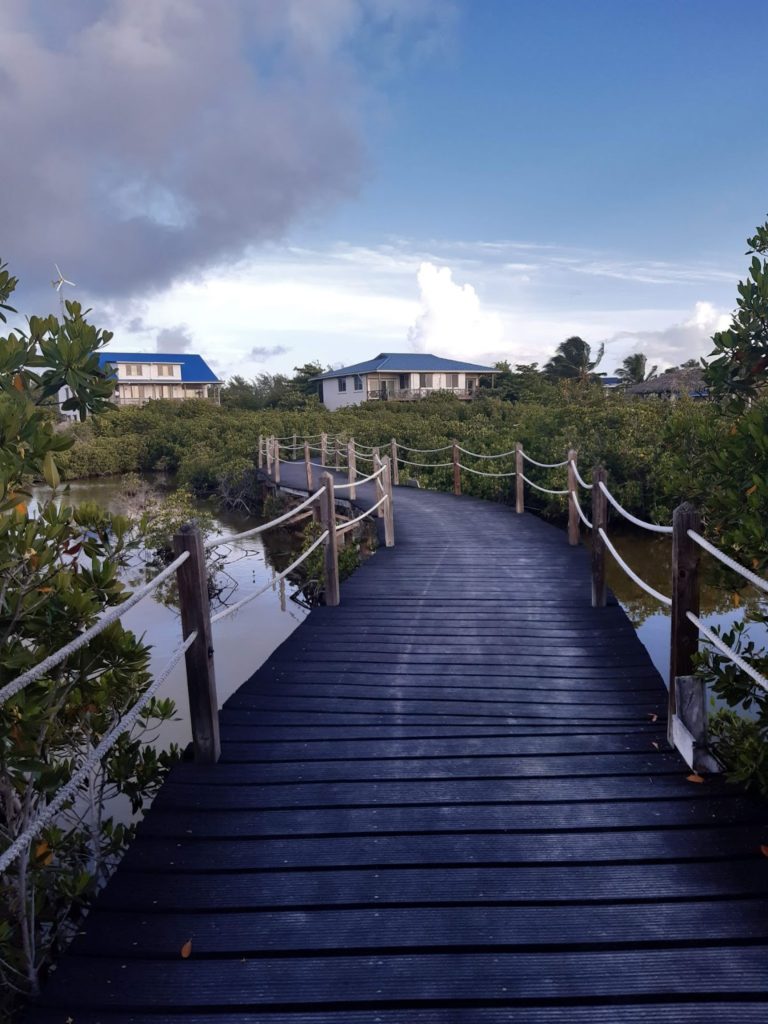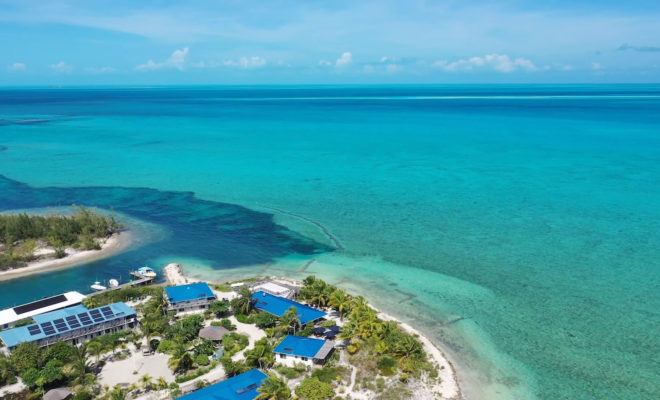By Bronwyn Esterhuizen, Research Scientist
On the north coast of the southwestern peninsula in Eleuthera, it’s hard to tell where land ends and sea begins. Mangroves and creek systems extend along the southern coast of Eleuthera from Wemyss Bight all the way to the Cape, buffering the settlements from the full strength of the tides and storm surges. As you drive nearer to The Island School, coastal landscaping is influenced by the presence of a road which gets closer and closer to the sea. In nature, the shoreline would naturally adapt to gradual environmental changes such as sea level rise. Here, as briny water rises to meet the freshwater of the creek, it would kill off terrestrial shrubs at the water’s edge and mangroves would grow in their place. But the road now lies so close to the coast that the mangroves have nowhere to go. In fact, the natural terrestrial shrubs have been replaced by invasive Casuarinas.
As you approach the entrance to The Island School and the tip of the Cape, the Casuarinas are replaced by native shrubbery and mangroves. Mangroves prevail in varying numbers and sizes from the easterly side of campus to the sandy beach following somewhat of a fresh water drainage system. This drainage system is supported by the recirculated salt water that is pumped from the ocean through the research wet lab which then drains back into the creek that supports our mangroves. Figure 1 depicts the Mangrove Bridge when it was first built in 2005. Figure 2 depicts the establishment of the mangroves since adding the recirculated sea water. This supported ecosystem in turn acts as a heat sink and sponge, absorbing the periodic flash floods of Deep Creek, providing much heat relief in the summer, and of course, supporting the habitats of smaller aquatic organisms.

The majority of The Island School campus was created with dredgings from the sea floor; as such, existing soil conditions consist of limestone gravel with little to no organic matter. This makes landscaping extremely challenging. The Island School campus provides great views and ocean access, but it also has a shifting coastal zone in need of reinforcement, not only by establishing mangrove systems, but also the establishment of natural coastal vegetation. Stabilizing our shoreline around campus is an ongoing endeavor. Various storms, including Hurricane Floyd of 1999, have taken their toll eroding parts of this shoreline. Following Floyd, rows of artificial reef balls were placed perpendicular to the shoreline slightly offshore to slow the currents and wave impact and allow suspended sand traveling in the water column to settle out on the seabed. They now also serve as habitats for fish and invertebrates.

In these parts of the world, much of the research around coastal restoration comes from projects in the southern United States, where once intact shorelines have been eroded by development, construction and hurricane damage. In the last decade, conservationists and academics have turned their attention to studying nature and the best ways to install more natural features, especially on Small Island Developing States (SIDS). This is spurred in part by the urgency of climate change as well as an influx in post-disaster funding. In the past, this has meant “hardening” the coast by installing concrete seawalls, jetties and other human-made physical barriers, but our research is looking at more diverse, cost effective and long term solutions such as coastal landscaping. We can achieve this by mimicking nature and observing what happens on other local beaches that use natural defenses like mangroves and coastal vegetation. Natural coastal features like dunes, mangroves, coral reefs, seagrass beds and other habitats can change, adapt over time and, when healthy, regenerate by themselves after storms, unlike concrete barriers and other hardened infrastructure. In addition, they have been shown to provide some protection for homes and communities from everyday erosion while also replacing lost habitat for birds and marine life.
Since The Island School is built on artificially constructed land and there was initially no existing vegetation, we cannot claim to be revegetating or restoring a once existing ecosystem. Rather, our aim is to mimic nature as best as possible to recreate natural mangroves, dunes and beaches. The last two terms of The Island School Semester, students observed and surveyed local beaches and compared anthropogenic impacts, the impacts of invasive species, plant groupings and climate resilient traits of plants that grow on the shoreline. This fall, Semester students will use this data to develop techniques to propagate native coastal plants and stock our nursery. The plants in turn will be used by the landscape team to reinforce the coastal landscape that divides and protects our campus from the shore itself.
The Island School is in a unique position to draw inspiration from remote beaches in close proximity and on both sides of the Cape peninsula, as well as from natural surroundings which are mostly intact native vegetation. The local beaches have varying degrees of accessibility and paint pictures of what a sound coastal ecosystem should look like from rocky shores to sandy beaches and even mangrove estuaries. The goal is to experiment with as many different native plants as possible and demonstrate what works best in our unique conditions with both poor soil and exposure.
In time to come, The Island School could not only be a demonstration site for coastal stabilization efforts, but also a nursery offering local gardeners a diverse palette of tried and tested native plants with which to landscape their shorelines.
For more information contact Bronwyn Esterhuizen bronwynesterhuizen@islandschool.org.
